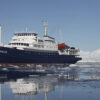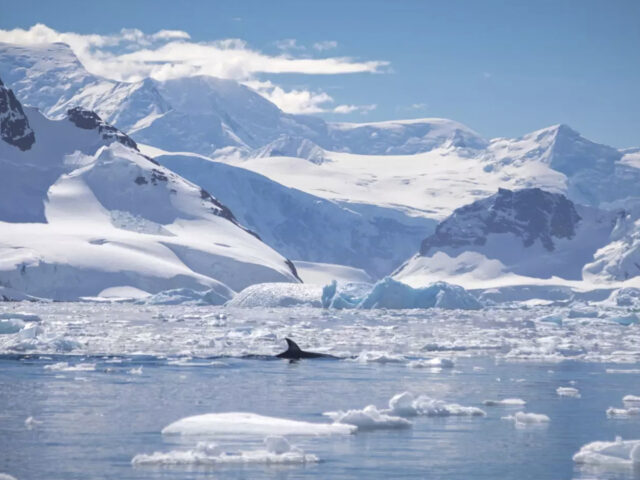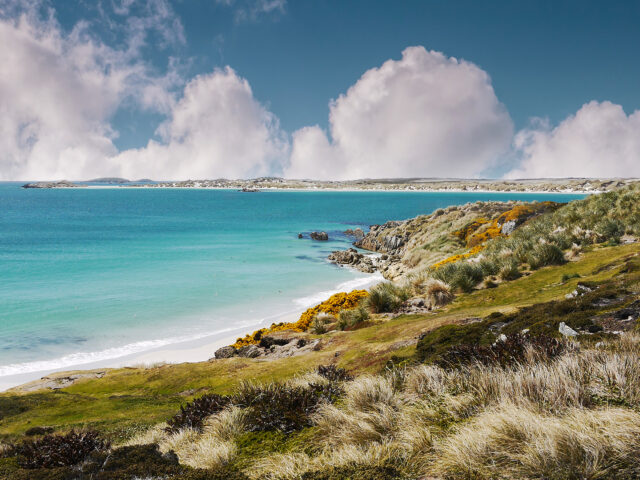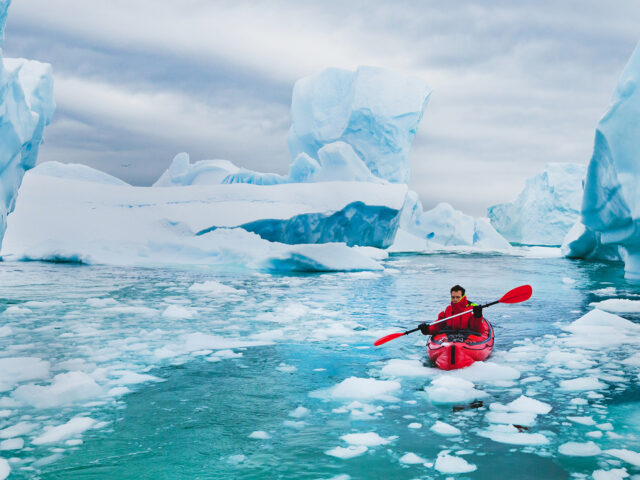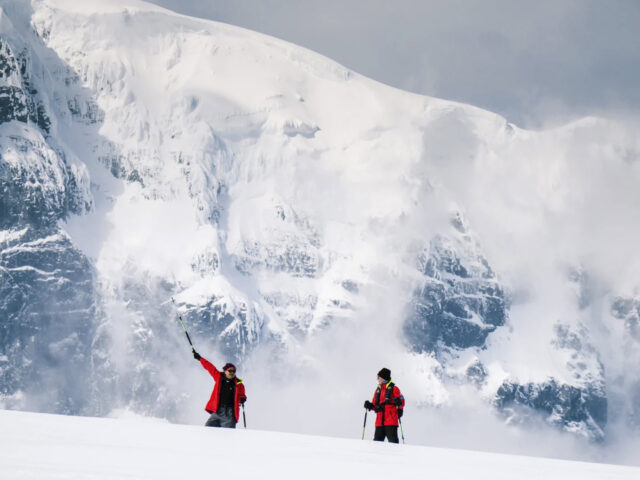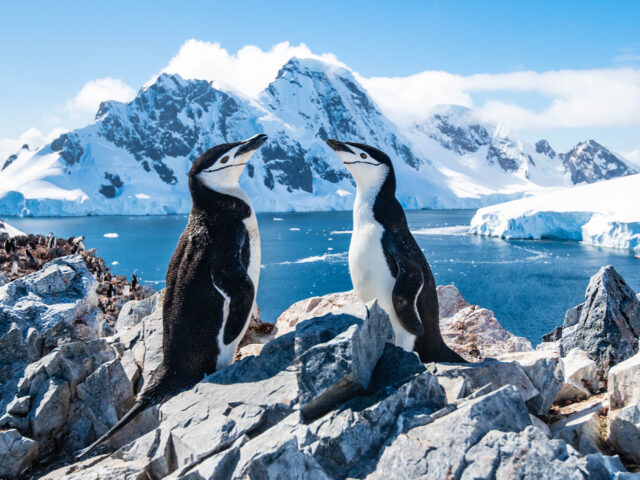Highlights
This expansive expedition takes you into the Antarctic Circle, combining the rich animal life of the Weddell Sea with the surreal shores and islands of the Antarctic Peninsula. Such key landing sites as the legendary Elephant Island and Crystal Sound make this voyage truly exceptional.
Standard Activities
About the Antarctica - Elephant Island - Weddell Sea - Polar Circle
This expansive expedition takes you into the Antarctic Circle, combining the rich animal life of the Weddell Sea with the surreal shores and islands of the Antarctic Peninsula. Such key landing sites as the legendary Elephant Island and Crystal Sound make this voyage truly exceptional.
Itinerary Day to Day
End of the world, start of a journey
Your voyage begins where the world drops off. Ushuaia, Argentina, reputed to be the southernmost city on the planet, is located on the far southern tip of South America. Starting in the afternoon, you embark from this small resort town on Tierra del Fuego, nicknamed “The End of the World,” and sail the mountain-fringed Beagle Channel for the remainder of the evening.
Path of the polar explorers
From Point Wild to the Weddell Sea
Weddell Sea Devil Island
Exploring the most remote regions
Orléans Strait whale search
Port monuments and island wildlife
Detaille Island’s historic station
Amazing Argentine islands
Farewell to Antarctica
Familiar seas, familiar friends
There and back again
Route Map
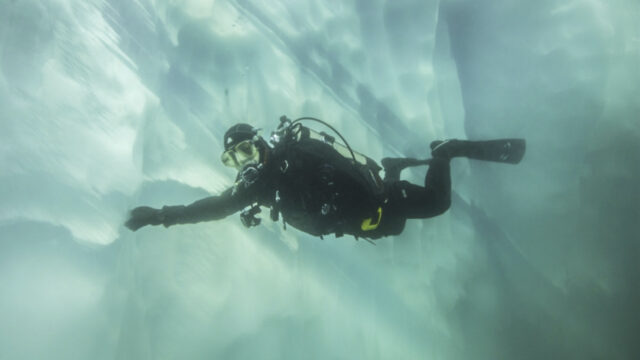
Antarctica’s dazzling icecaps, colossal glaciers, and towering mountains are rivaled only by the white-sand beaches and lush flora of the sub-Antarctic islands. Both areas host a large variety of penguins, whales, seals, and seabirds. We dive from our Zodiacs, exploring ice walls, marine life, and sometimes shipwrecks at shallow depths (around 20 meters / 65 feet).
During these dives, you may observe penguins, fur seals, and perhaps even leopard seals. Many of the sub-Antarctic islands are also rich with krill, one of the prime food sources for many marine species and therefore highly useful in locating wildlife.
Weather
In Antarctica’s Southern Hemisphere summer (December to February), temperatures are generally close to freezing, varying between -5 to 8°C (23 to 46°F). Combined with the strong katabatic winds of this area, the cold can often feel even colder.Warm and waterproof clothing (and a flexible attitude) is required for both regions, especially Antarctica. Severe weather may lead to the cancellation of landings and dives, as excursions can only take place in safe conditions.
Program changes due to weather and ice
We know our dive destinations in great detail and are always exploring new sites, but every dive can encounter surprises. It is important to remember that nature calls the shots in the polar regions. Personal expectations that are not met are not grounds for reimbursement.Please note that our itinerary is always subject to safe local conditions. It is always possible that ice, weather, or wildlife will force us to change our sailing schedule. It is also possible that certain bays or fjords will be closed because of ice.In such cases, we always have planned alternatives. But again, these alternatives are not grounds for reimbursement. When changing the itinerary, we assure you that the captain, expedition leader, and dive leader will do their utmost to provide you an equally good replacement program.
Dive experience and qualifications
Our polar dive voyages are not for beginners. They are meant for experienced divers who are familiar with cold-water, dry-suit diving. You must have logged at least 30 dry-suit dives to participate.
Before departure, please present an internationally accepted diving certificate and logbook. Also, we ask that you include copies when completing your diver personal information form.
The first dive of our voyage will be a “check dive” to try out your gear and assure our dive leader that you have enough experience to participate. This is for your safety and that of our guides.
If our dive leaders feel that any diver does not meet the necessary experience, they can exclude that diver from the dive program. In this event, the Expedition cannot be held responsible and will grant no claims for reimbursement.
Expedition team, excursions, & dive leaders
Our expedition team consists of one expedition leader and multiple guide-lecturers. All members of the team are extensively experienced in working in the polar wilderness.Every morning after breakfast, you will be informed of the day’s program (position of the vessel, general information about the area, itinerary, and expected wildlife during the excursions). The excursions will then be evaluated in the afternoon and after dinner.
Occasionally, the expedition team will organize lectures, sometimes supported with slide shows, to inform the passengers about various features of the polar environment.Our dive leaders are highly experienced instructors assisted by one or two dive guides. The main language of all guides and dive operations is English unless otherwise stated.
Special note: Safety first
Diving in the remote polar regions is no more dangerous than normal scuba diving as long as you follow one important rule: safety first.All divers looking for dangerous stunts or deep dives are asked to refrain from this activity. There are no decompression chambers in Antarctica or the Arctic, medical care is almost non-existent, and there is hardly any infrastructure. Although we have a doctor on board the vessel for first-aid assistance, we cannot accept risky ventures from any divers.
Dive Procedures
In normal circumstances, the number of divers per Zodiac is six passengers as well as one driver-guide. Always watch your valuable gear when embarking and disembarking the Zodiacs. The Expedition is not liable for the loss of individual equipment.
Check dive
The voyage starts with a check dive so that all divers can get used to the cold water, try out their equipment, and determine the weights they need. Before each dive, there will be a briefing about the dive site, weather and ice conditions, and the procedure of the dive.
Currents
Water currents can be present anywhere and at any time. The dive guides will select a dive spot that is safe and also give information about returning to the Zodiacs if needed. Normally there is very little current where we dive, if any.
Dive buddy
Dives will be made using the buddy system. The dive guide will not be in the water to accompany and lead divers. Rather, dive guides stay on the surface for the divers’ safety. Divers are expected to be experienced enough to read their compasses and depth gauges and look after each other. Buddy teams are important, so we let our divers match themselves as much as possible. In cases where divers have not paired up or are in doubt, dive guides sit with divers to discuss their expectations and experience. We try to pair people of similar interests and experience. If there is an uneven number of divers and three-person groups are not feasible, dive guides will accompany divers.
Dive guide-to-diver ratio
Our programs allow for six divers per dive guide, with a preferred maximum of 24 diving passengers per voyage. Groups larger than 24 will need to split dive activities, and we also may reduce the number of dives so that we can safely manage activities.
Drifting pack ice
This is a real hazard. If pack ice approaches while divers are underwater, it can be hard to see people if they surface in the middle of it. For this reason, it is important to only dive around icebergs that are hard aground or floating in water clear of brash or pack ice. Many of the dive sites have slopes or faces that go deeper than the 20 meters (65 feet) maximum limit for our dives. Divers must act responsibly and show self-discipline.
Equipment
Once you have settled into your cabin, you will be given an area to store and hang your equipment. Every diver is expected to prepare their own equipment in advance of each dive. Bring your own spare parts for regulators and dry suits in case of leaks or damage.
Divers are expected to set up and carry their own equipment in and out of the Zodiac as well as up and down the gangway.
Number of dives
We plan for one to two dives per day, but an exact number of dives cannot be given due to the possibility of variable ice and weather conditions.
Visibility
Ample pack ice often means flat water with clear visibility. Little pack ice can mean plankton blooms, because there is more daylight and possibility of swells. But the ice and weather conditions are different every year, so there is no way to predict them.
Dive Equipment
Please bring the following equipment yourself:
Dry suit with hood
Two sets of warm underwater garments
Dry gloves or wet gloves/mitts adequate for sub-zero waters
Two freeze-protected regulators. (We dive with special bottles that have two separate outlets, and we use 12L steel tanks fitted with a Y or H valve configuration and DIN or Yoke (INT) adaptable connections.)
Stabilizing jacket or BC with quick-release capability and sufficient lift capacity
Pressure gauge
Compass watch
Knife and torch
Mask, fins, and snorkel
Equipment we provide on board
Tanks
On all diving vessels, we have a compressor and 35 steel tanks of 12 liters each (200 bar), with DIN and Yoke adaptable connections and two separate outlets.
Weights
You will be provided with hard lead weights and a belt, but there are no ankle weights available. You may bring and use your own weight harness.
Diving FAQ & final notes
How deep do we dive?
Our maximum depth is 20 meters (65 feet). Many dive sites have slopes or faces that go deeper than this, so divers must act responsibly and show self-discipline.
What is the average visibility?
Ample pack ice often means flat water and clear visibility, while little pack ice can mean plankton blooms due to additional daylight and swells. But ice and weather conditions are different every year, making visibility unpredictable.
What about currents and drift dives?
Currents are specifically mentioned at some of the sites where they may pose a problem. Currents could be present anywhere, at any time. We always check the current before diving. We do not do drift dives. Drifting pack ice makes this too hazardous. If ice arrives while divers are underwater, it can be hard to see them if they surface among it. We only dive near icebergs that are hard aground or floating in water clear of brash ice or pack ice.
Do I need a full-face mask?
This is up to you and based on whether you are used to diving with a full mask.
What type of gloves should I bring?
Use a minimum of 7mm wetsuit gloves, otherwise we recommend dry suit gloves.Why do I need two regulators?We dive with two separate outlets (DIN and Yoke connection), so in case of a free flow (freezing) of one of your regulators, you have the second regulator as a back-up.
Can I have one regulator with DIN valves and the other with ISO?
Yes, we have adapters on board that we can put in the valve to connect with an ISO regulator. The DIN connection will fit without the adapter.
Do I need a waterproof bag to carry my smaller items?
It is good to bring a waterproof bag to use while preparing your dive equipment on deck. In the Zodiac, it is best not to bring more than your necessary dive equipment.
What is the water temperature in the polar regions?
Around freezing or slightly below.
Final notes
- Polar diving is an equipment-intensive activity, and ice diving in particular requires extensive equipment due to the cold and remote locations. Divers in cold water may have higher air consumption, expend more energy, and become fatigued easier. Cold water also decreases your ability to perform complex manual tasks.
- The snorkel is a vital part of your safety equipment and will often be used when diving with seals and other wildlife.
- Do not bring any new equipment you have not tested in the water. The polar regions are not the place to test new equipment. Please make sure you have done at least four or five dives with your equipment. This will allow you to fine-tune your buoyancy, trim characteristics, and take note of how much weight you need when diving.
- Contact your airline about luggage restrictions and request a special allowance for your dive equipment prior to departure. All excess baggage is at your own expense.
- Divers are expected to prepare their own equipment in advance of each dive and take care of it afterward.
- Bring spare parts for your regulators and dry suit in case of leaks or damage.
- We do not have rentals on board. Please make sure you check out all your dive gear before leaving. Bins are available for storage.
- Keep in mind while packing dive gear that you will need to carry your own equipment in and out of the Zodiac for filling and logistical changes.
- Please get travel insurance! Participation in an expedition cruise is 100% at your own risk. In our travel documentation (specifically our personal information form for scuba diving), all passengers need to sign a liability statement in which they agree that the operator and dive staff are exempt from responsibility for personal injury and property damage, including loss of items. We cannot accept any liability claims.
One of the best things about a polar voyage is that you’re never done exploring. Even if you think you have walked every shore, climbed every mountain, and spotted every penguin (or polar bear), there is still a whole other world to explore on the water.
Polar kayaking is a great way to tour the blue-and-white beauty of the polar seas up close, visiting stunning ice formations and waterways too small for our ships to enter.
Do I need to be an experienced kayaker?
The amount of experience we require depends on the cruise you choose. If you have no experience at all, we suggest one of our Basecamp voyages, where we will happily introduce even the most inexperienced kayakers to this wonderful outdoor sport.
The toughest part of kayaking in gentle waters is usually getting into the kayak itself. After that, you just have to keep a steady rhythm with your paddles.
Some of our cruises require that you have more kayaking experience because they involve longer kayak excursions. These excursions expose you to water that might not be as gentle as a sheltered bay, and you stand more of a chance of encountering rougher weather conditions.
You will not need to be able to do a kayak roll, but you should be able to demonstrate that you’re comfortable in a sea kayak. On these non-Basecamp excursions, our guides reserve the right to refuse you access to a kayak if it is clear you don’t have the necessary experience. This is for your safety as well as theirs.
How physically fit do I need to be?
You will want to be in decent physical shape and possess a good sense of balance. Kayaking can be demanding on your core and arm muscles.
Is polar kayaking safe?
All of our kayaking outings are led by certified and experienced guides, but you must always take caution when kayaking in the polar regions.
We will provide you with suitable outer clothing for kayaking. Kayak excursions are limited to 14 passengers per kayak guide. This number lets our guides keep track of everyone and make sure our guests are having a good time.
One guide stays with the group in a support kayak, while a safety boat follows in case of emergencies. All guides will try to scale excursions to the skill level of the group.
Do I have to bring my own kayaking equipment?
We will provide the following items:
- Seven double-seat sea kayaks on Plancius & Ortelius
- 14 double-seat sea kayaks on Hondius & Janssonius
- Paddles with anti-drip rings
- Basic (4 mm neoprene) wetsuits in different sizes
- Kayak spray cover
- Waterproof lightweight jacket (cagoule)
- Life jacket / kayak vest
- Neoprene boots
Please bring the following gear:
- thermal underwear, bottom and top (for under the wetsuit)
- fleece jacket or vest to wear over your thermal underwear
- gloves (insulated ski or snowboard gloves with grip or neoprene watersport gloves)
- waterproof bag (if you are bringing a camera or binoculars)
- fleece hat
- turtleneck or neck gaiter
- thick socks
- sunglasses
- sunblock
Avoid bringing cloth clothing like T-shirts or jeans. Once it gets wet (from water or sweat), it will stay wet for a long time – not a comfortable experience in polar weather!
What will I see while kayaking?
You’ll see rugged shorelines sloping up into snow-capped mountains, pristine beaches, and icebergs that turn the water beneath you a brilliant blue. You may also see some local wildlife, which the peaceful nature of kayaking makes even better.
***Only available on departure 03/07/2024
What's Included
-
Voyage aboard the indicated vessel as indicated in the itinerary
-
All meals throughout the voyage aboard the ship including snacks, coffee and tea.
-
All shore excursions and activities throughout the voyage by Zodiac.
-
Program of lectures by noted naturalists and leadership by experienced expedition staff.
-
Free use of rubber boots and snowshoes.
-
Luggage transfer from pick-up point to the vessel on the day of embarkation, in Ushuaia.
-
Pre-scheduled group transfer from the vessel to the airport in Ushuaia (directly after disembarkation).
-
All miscellaneous service taxes and port charges throughout the programme.
-
Comprehensive pre-departure material.
What's Excluded
-
Mandatory travel insurance
-
Any airfare, whether on scheduled or charter flights
-
Pre- and post- land arrangements.
-
Passport and visa expenses.
-
Government arrival and departure taxes.
-
Meals ashore.
-
Baggage, cancellation and personal insurance (which is strongly recommended).
-
Excess baggage charges and all items of a personal nature such as laundry, bar, beverage charges and telecommunication charges.
-
The customary gratuity at the end of the voyages for stewards and other service personnel aboard (guidelines will be provided).










































